Bird Survival in Wind Farms by Monte-Carlo Simulation Modelling Based on Wide-Ranging Flight Tracking Data of Multiple Birds During Different Seasons
Simple Summary
Abstract
1. Introduction
2. Materials and Methods
2.1. Study Area
2.2. Study Species
2.3. Study Design and Concepts
2.4. Data Collection
2.4.1. GPS Tracking
2.4.2. Visual Observations
2.5. Carcass Searches
2.6. Data Processing and Modelling
3. Results
3.1. Flight Height Distributions
3.2. Seasonal Variations in Number of Birds at the Risk Zone
4. Discussion
5. Conclusions
Supplementary Materials
Author Contributions
Funding
Institutional Review Board Statement
Data Availability Statement
Acknowledgments
Conflicts of Interest
References
- Plan, B.A. Commission Staff Working Document. In Implementing the REPower EU Action Plan: Investment Needs, Hydrogen Accelerator and Achieving the Bio-Methane Targets; European Commission: Brussels, Belgium, 2022. [Google Scholar]
- Europe, W. Wind Energy in Europe: 2022 Statistics and the Outlook for 2023–2027; WindEurope: Brussels, Belgium, 2023. [Google Scholar]
- Erickson, W.P.; Johnson, G.D.; Strickland, D.M.; Young, D.P., Jr.; Sernka, K.J.; Good, R.E. Avian Collisions with Wind Turbines: A Summary of Existing Studies and Comparisons to Other Sources of Avian Collision Mortality in the United States; Western EcoSystems Technology, Inc.: Cheyenne, WY, USA, 2001. [Google Scholar]
- Marques, A.T.; Batalha, H.; Bernardino, J. Bird Displacement by Wind Turbines: Assessing Current Knowledge and Recommendations for Future Studies. Birds 2021, 2, 460–475. [Google Scholar] [CrossRef]
- NatureScot Research Report 909-Using a Collision Risk Model to Assess Bird Collision Risks for Onshore Wind Farms | NatureScot. Available online: https://www.nature.scot/doc/naturescot-research-report-909-using-collision-risk-model-assess-bird-collision-risks-onshore-wind (accessed on 16 September 2025).
- Madders, M.; Whitfield, D.P. Upland Raptors and the Assessment of Wind Farm Impacts. Ibis 2006, 148, 43–56. [Google Scholar] [CrossRef]
- Whitfield, D.P.; Madders, M. A Review of the Impacts of Wind Farms on Hen Harriers Circus Cyaneus and an Estimation of Collision Avoidance Rates. Natural Research Information Note 1 (revised); Natural Research Ltd: Banchory, UK, 2006. [Google Scholar]
- de Lucas, M.; Janss, G.F.; Ferrer, M. Birds and Wind Farms: Risk Assessment and Mitigation; Quercus/Libreria Linneo: Madrid, Spain, 2007. [Google Scholar]
- De Lucas, M.; Ferrer, M.; Bechard, M.J.; Muñoz, A.R. Griffon Vulture Mortality at Wind Farms in Southern Spain: Distribution of Fatalities and Active Mitigation Measures. Biol. Conserv. 2012, 147, 184–189. [Google Scholar] [CrossRef]
- de Lucas, M.; Ferrer, M.; Janss, G.F. Using Wind Tunnels to Predict Bird Mortality in Wind Farms: The Case of Griffon Vultures. PLoS ONE 2012, 7, e48092. [Google Scholar] [CrossRef] [PubMed]
- Whitfield, D.P. Collision Avoidance of Golden Eagles at Wind Farms under the ‘Band’Collision Risk Model; Natural Research Ltd.: Banchory, UK, 2009. [Google Scholar]
- Ferrer, M.; De Lucas, M.; Janss, G.F.E.; Casado, E.; Muñoz, A.R.; Bechard, M.J.; Calabuig, C.P. Weak Relationship between Risk Assessment Studies and Recorded Mortality in Wind Farms. J. Appl. Ecol. 2012, 49, 38–46. [Google Scholar] [CrossRef]
- Dahl, E.L.; May, R.; Hoel, P.L.; Bevanger, K.; Pedersen, H.C.; Røskaft, E.; Stokke, B.G. White-tailed Eagles (Haliaeetus Albicilla) at the Smøla Wind-power Plant, Central Norway, Lack Behavioral Flight Responses to Wind Turbines. Wildl. Soc. Bull. 2013, 37, 66–74. [Google Scholar] [CrossRef]
- Thaxter, C.B.; Buchanan, G.M.; Carr, J.; Butchart, S.H.M.; Newbold, T.; Green, R.E.; Tobias, J.A.; Foden, W.B.; O’Brien, S.; Pearce-Higgins, J.W. Bird and Bat Species’ Global Vulnerability to Collision Mortality at Wind Farms Revealed through a Trait-Based Assessment. Proc. R. Soc. B Biol. Sci. 2017, 284, 20170829. [Google Scholar] [CrossRef]
- Katzner, T.; Smith, B.W.; Miller, T.A.; Brandes, D.; Cooper, J.; Lanzone, M.; Brauning, D.; Farmer, C.; Harding, S.; Kramar, D.E. Status, Biology, and Conservation Priorities for North America’s Eastern Golden Eagle (Aquila Chrysaetos) Population. Auk 2012, 129, 168–176. [Google Scholar]
- Watson, J.W.; Duff, A.A.; Davies, R.W. Home Range and Resource Selection by GPS-Monitored Adult Golden Eagles in the Columbia Plateau Ecoregion: Implications for Wind Power Development: Golden Eagle Range and Resource Selection. J. Wildl. Manag. 2014, 78, 1012–1021. [Google Scholar] [CrossRef]
- Reid, T.; Krüger, S.; Whitfield, D.P.; Amar, A. Using Spatial Analyses of Bearded Vulture Movements in Southern Africa to Inform Wind Turbine Placement. J. Appl. Ecol. 2015, 52, 881–892. [Google Scholar] [CrossRef]
- GeographicLib: GeographicLib Library. Available online: https://geographiclib.sourceforge.io/1.51/ (accessed on 16 September 2025).
- Tikkanen, H.; Pakanen, V.-M.; Karlin, O.-P.; Lamminmäki, J. Survival Estimates of GPS-Tagged Adult Golden Eagles (Aquila Chrysaetos) Breeding in Finland. Ornis Fenn. 2024, 101, 91–100. [Google Scholar] [CrossRef]
- Cervellini, M.; Zannini, P.; Di Musciano, M.; Fattorini, S.; Jiménez-Alfaro, B.; Rocchini, D.; Field, R.; Vetaas, O.R.; Irl, S.D.; Beierkuhnlein, C. A Grid-Based Map for the Biogeographical Regions of Europe. Biodivers. Data J. 2020, 8, e53720. [Google Scholar] [CrossRef]
- Tikkanen, H.; Rytkönen, S.; Karlin, O.-P.; Ollila, T.; Pakanen, V.-M.; Tuohimaa, H.; Orell, M. Modelling Golden Eagle Habitat Selection and Flight Activity in Their Home Ranges for Safer Wind Farm Planning. Environ. Impact Assess. Rev. 2018, 71, 120–131. [Google Scholar] [CrossRef]
- Vasilakis, D.P.; Whitfield, D.P.; Schindler, S.; Poirazidis, K.S.; Kati, V. Reconciling Endangered Species Conservation with Wind Farm Development: Cinereous Vultures (Aegypius Monachus) in South-Eastern Europe. Biol. Conserv. 2016, 196, 10–17. [Google Scholar] [CrossRef]
- Barrios, L.; Rodríguez, A. Behavioural and Environmental Correlates of Soaring-bird Mortality at On-shore Wind Turbines. J. Appl. Ecol. 2004, 41, 72–81. [Google Scholar] [CrossRef]
- Dürr, T. “Vogelverluste an Windenergieanlagen in Deutschland. Daten aus der Zentralen Fundkartei der Staatlichen Vogelschutzwarte. Landesamt für Umwelt, Gesundheit und Verbraucherschutz Brandenburg 2014”. 2019. Available online: https://scholar.google.com/scholar?hl=bg&as_sdt=0%2C5&q=21.%09D%C3%BCrr%2C+T.+Vogelverluste%E2%80%A6 (accessed on 16 September 2025).
- Smallwood, K.S.; Thelander, C. Bird Mortality in the Altamont Pass Wind Resource Area, California. J. Wildl. Manag. 2008, 72, 215–223. [Google Scholar] [CrossRef]
- Loss, S.R.; Will, T.; Marra, P.P. Estimates of Bird Collision Mortality at Wind Facilities in the Contiguous United States. Biol. Conserv. 2013, 168, 201–209. [Google Scholar] [CrossRef]
- Whitfield, D.P.; Madders, M. Deriving Collision Avoidance Rates for Red Kites Milvus Milvus. Nat. Res. Inf. Note 2006, 3, 1–14. [Google Scholar]
- Whitfield, D.P. Turbine Shutdown Systems for Birds at Wind Farms: A Review and Application at the St. Nikola Wind Farm, Kaliakra, Bulgaria; AES Geo Energy OOD: Sofia, Bulgaria, 2018. [Google Scholar]
- McGregor, R.M.; King, S.; Donovan, C.R.; Caneco, B.; Webb, A. A Stochastic Collision Risk Model for Seabirds in Flight; Marine Scotland Science Report. HC0010–400–001; HiDef: Cumbria, UK, 2018. [Google Scholar]
- Ross-Smith, V.H.; Thaxter, C.B.; Masden, E.A.; Shamoun-Baranes, J.; Burton, N.H.K.; Wright, L.J.; Rehfisch, M.M.; Johnston, A. Modelling Flight Heights of Lesser Black-backed Gulls and Great Skuas from GPS: A Bayesian Approach. J. Appl. Ecol. 2016, 53, 1676–1685. [Google Scholar] [CrossRef]
- Garvin, J.C.; Simonis, J.L.; Taylor, J.L. Does Size Matter? Investigation of the Effect of Wind Turbine Size on Bird and Bat Mortality. Biol. Conserv. 2024, 291, 110474. [Google Scholar] [CrossRef]
- Huso, M.; Conkling, T.; Dalthorp, D.; Davis, M.; Smith, H.; Fesnock, A.; Katzner, T. Relative Energy Production Determines Effect of Repowering on Wildlife Mortality at Wind Energy Facilities. J. Appl. Ecol. 2021, 58, 1284–1290. [Google Scholar] [CrossRef]
- Johnston, A.; Cook, A.S.C.P.; Wright, L.J.; Humphreys, E.M.; Burton, N.H.K. Modelling Flight Heights of Marine Birds to More Accurately Assess Collision Risk with Offshore Wind Turbines. J. Appl. Ecol. 2014, 51, 31–41. [Google Scholar] [CrossRef]
- Paint It Black: Efficacy of Increased Wind Turbine Rotor Blade Visibility to Reduce Avian Fatalities-May-2020-Ecology and Evolution-Wiley Online Library. Available online: https://onlinelibrary.wiley.com/doi/10.1002/ece3.6592 (accessed on 16 September 2025).
- Balmori-de la Puente, A.; Balmori, A. Flight Type and Seasonal Movements Are Important Predictors for Avian Collisions in Wind Farms. Birds 2023, 4, 85–100. [Google Scholar] [CrossRef]
- Beston, J.A.; Diffendorfer, J.E.; Loss, S.R.; Johnson, D.H. Prioritizing Avian Species for Their Risk of Population-Level Consequences from Wind Energy Development. PLoS ONE 2016, 11, e0150813. [Google Scholar] [CrossRef]
- Schaub, T.; Klaassen, R.H.G.; Bouten, W.; Schlaich, A.E.; Koks, B.J. Collision Risk of Montagu’s Harriers Circus Pygargus with Wind Turbines Derived from High-resolution GPS Tracking. Ibis 2020, 162, 520–534. [Google Scholar] [CrossRef]
- Bellebaum, J.; Korner-Nievergelt, F.; Dürr, T.; Mammen, U. Wind Turbine Fatalities Approach a Level of Concern in a Raptor Population. J. Nat. Conserv. 2013, 21, 394–400. [Google Scholar] [CrossRef]
- AES Geo Energy. Available online: https://www.aesgeoenergy.com/ (accessed on 16 September 2025).
- Kaliakra Bird Monitoring-Home. Available online: https://kaliakrabirdmonitoring.eu/ (accessed on 16 September 2025).
- Band, W. Windfarms and Birds: Calculating a Theoretical Collision Risk Assuming No Avoiding Action. In Scottish Natural Heritage Guidance Note 2000; Scottish Natural Heritage: Inverness, UK, 2000. [Google Scholar]
- Marinova, T.; Malcheva, K.; Bocheva, L.; Trifonova, L. Climate Profile of Bulgaria in the Period 1988–2016 and Brief. Bulg. J. Meteorol. Hydrol. 2017, 22, 2–25. [Google Scholar]
- Popov, V. Terrestrial Mammals of Bulgaria: Zoogeographical and Ecological Patterns of Distribution. In Biogeography and Ecology of Bulgaria; Fet, V., Popov, A., Eds.; Springer: Dordrecht, The Netherlands, 2007; pp. 9–37. ISBN 978-1-4020-5781-6. [Google Scholar]
- Stoyanov, A.; Tzankov, N.; Naumov, B. Die Amphiben Und Reptilien Bulgariens. Chimaira, Frankfurt Am Main; 2011; p. 588. Available online: https://www.researchgate.net/publication/260246052_Stoyanov_A_N_Tzankov_B_Naumov_2011_Die_Amphiben_und_Reptilien_Bulgariens_Chimaira_Frankfurt_am_Main_588_p (accessed on 16 September 2025).
- Eurasian Buzzard Buteo Buteo Species Factsheet. Available online: https://datazone.birdlife.org/species/factsheet/eurasian-buzzard-buteo-buteo (accessed on 16 September 2025).
- Simmons, K.E.L. Handbook of the Birds of Europe, the Middle East and North Africa. The Birds of the Western Palearctic. Volume II-Hawks to Bustards; Oxford University Press: Oxford, UK, 1980. [Google Scholar]
- Gryz, J.; Krauze-Gryz, D. The Common Buzzard Buteo Buteo Population in a Changing Environment, Central Poland as a Case Study. Diversity 2019, 11, 35. [Google Scholar] [CrossRef]
- Michev, T.M.; Proirov, L.A.; Karaivanov, N.P.; Michev, B.T. Migration of Soaring Birds over Bulgaria. Acta Zool. Bulg. 2012, 64, 33–41. [Google Scholar]
- Smith, D.A. There Is No Such Thing as “The” EGM96 Geoid: Subtle Points on the Use of a Global Geopotential Model. IGeS Bull. 1998, 8, 17–28. [Google Scholar]
- Morrison, M.L.; Block, W.M.; Strickland, M.D.; Collier, B.A.; Peterson, M.J. Experimental Designs. In Wildlife Study Design; Springer Series on Environmental Management; Springer New York: New York, NY, USA, 2008; pp. 77–135. ISBN 978-0-387-75527-4. [Google Scholar]
- R: The R Project for Statistical Computing. Available online: https://www.r-project.org/ (accessed on 16 September 2025).
- Rapp, R.H. Use of Potential Coefficient Models for Geoid Undulation Determinations Using a Spherical Harmonic Representation of the Height Anomaly/Geoid Undulation Difference. J. Geod. 1997, 71, 282–289. [Google Scholar] [CrossRef]
- Tikkanen, H.; Balotari-Chiebao, F.; Laaksonen, T.; Pakanen, V.-M.; Rytkönen, S. Habitat Use of Flying Subadult White-Tailed Eagles (Haliaeetus Albicilla): Implications for Land Use and Wind Power Plant Planning. Ornis Fenn. 2018, 95, 137–150. [Google Scholar] [CrossRef]
- Schaub, T.; Klaassen, R.H.G.; De Zutter, C.; Albert, P.; Bedotti, O.; Bourrioux, J.-L.; Buij, R.; Chadœuf, J.; Grande, C.; Illner, H.; et al. Effects of Wind Turbine Dimensions on the Collision Risk of Raptors: A Simulation Approach Based on Flight Height Distributions. Sci. Total Environ. 2024, 954, 176551. [Google Scholar] [CrossRef]
- Dorey, K.; Dickey, S.; Walker, T.R. Testing Efficacy of Bird Deterrents at Wind Turbine Facilities: A Pilot Study in Nova Scotia, Canada. Proc. Nova Scotian Inst. Sci. NSIS 2019, 50, 91–108. [Google Scholar] [CrossRef]

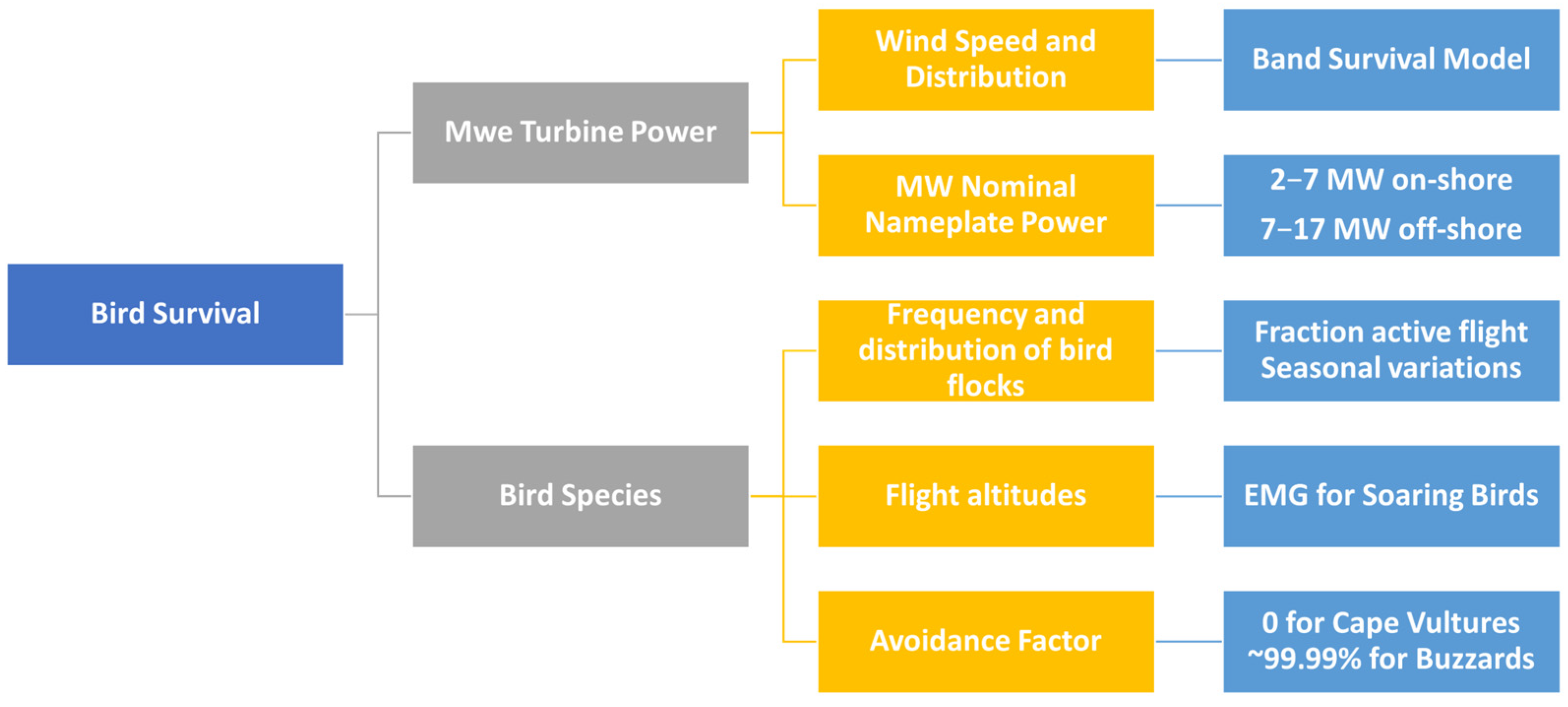


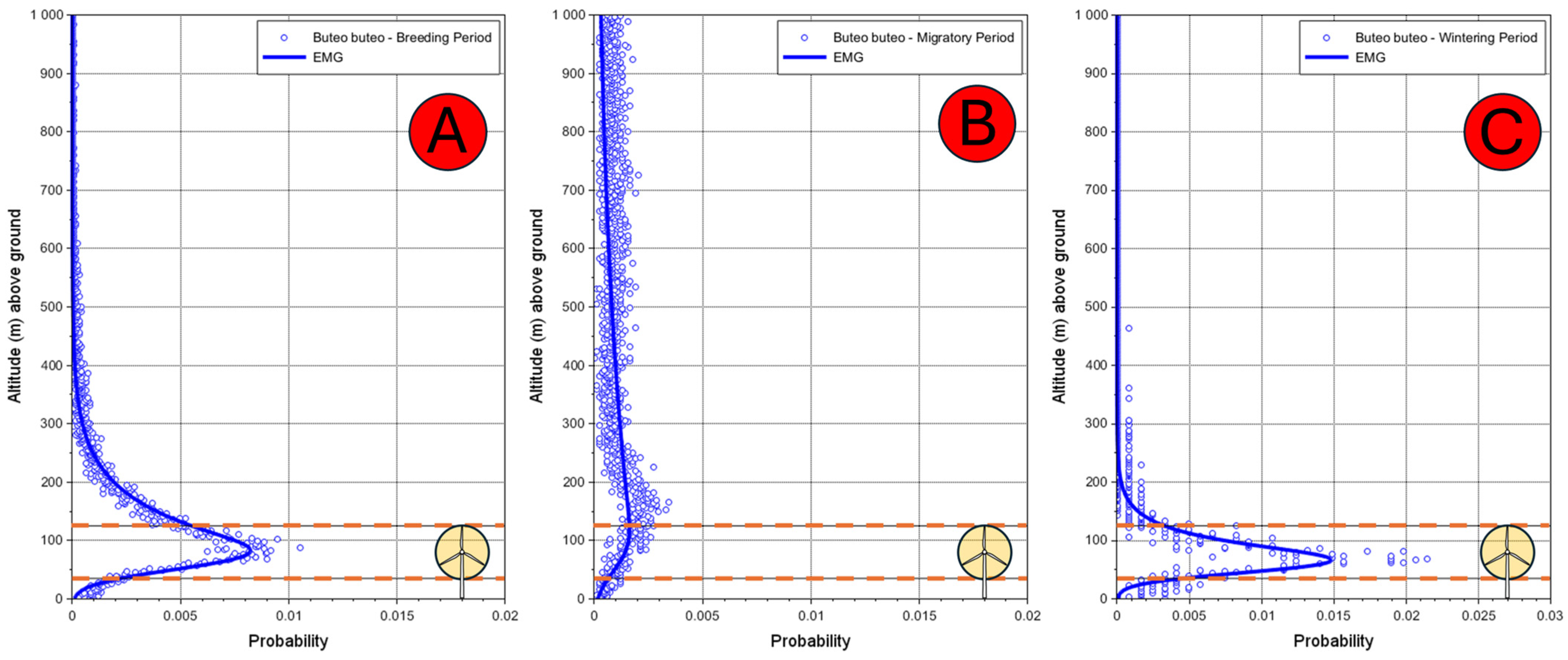
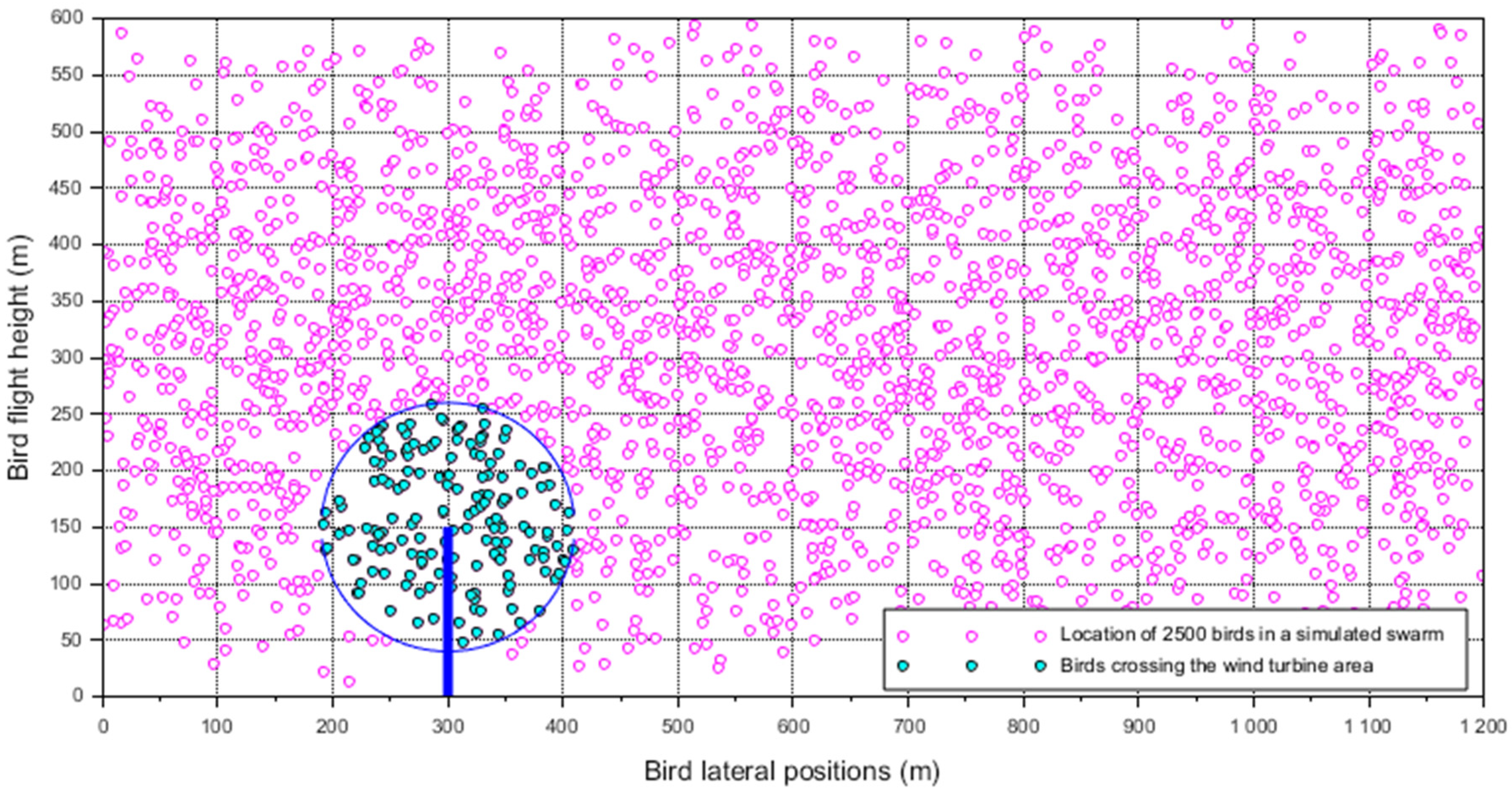

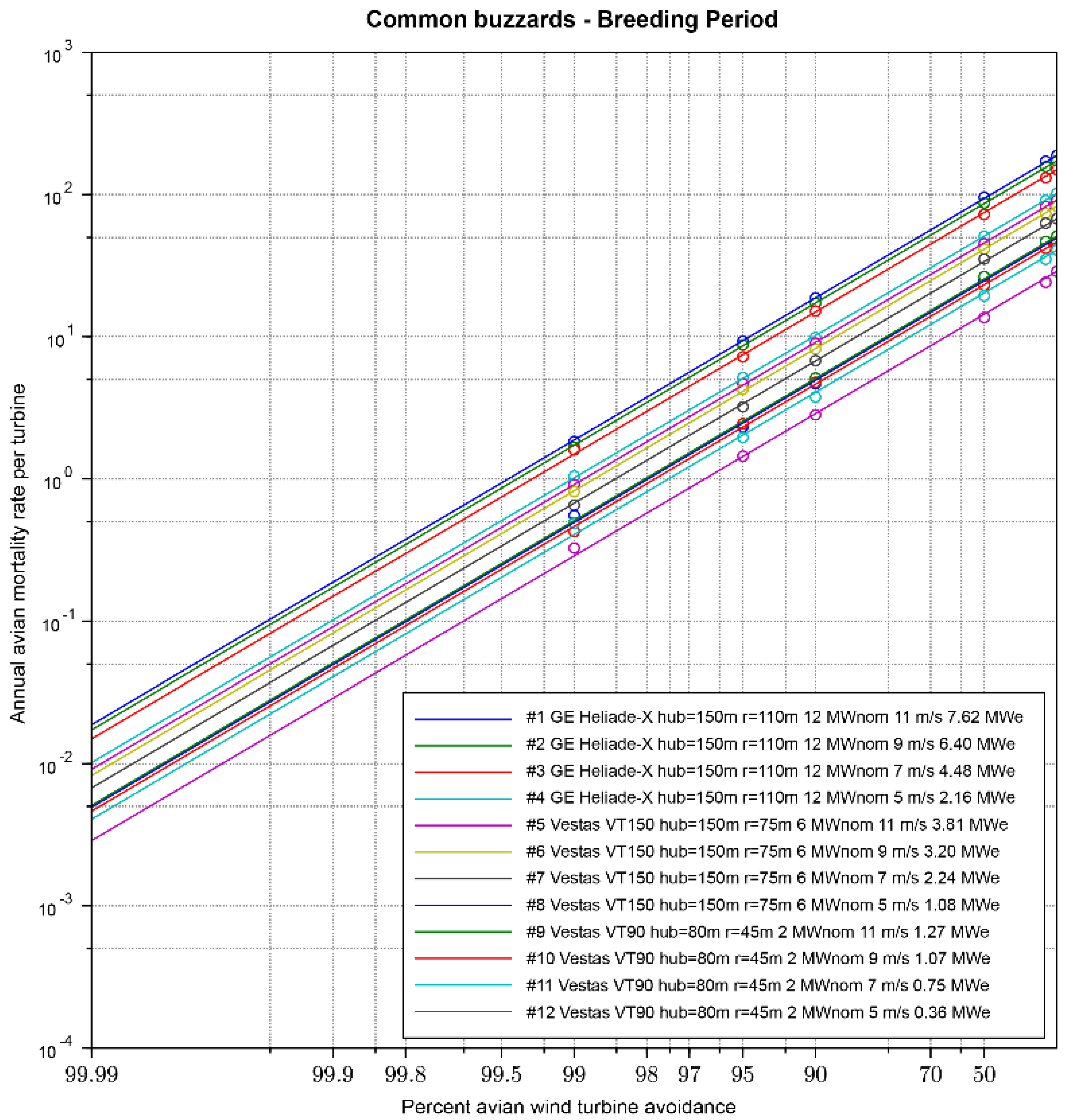

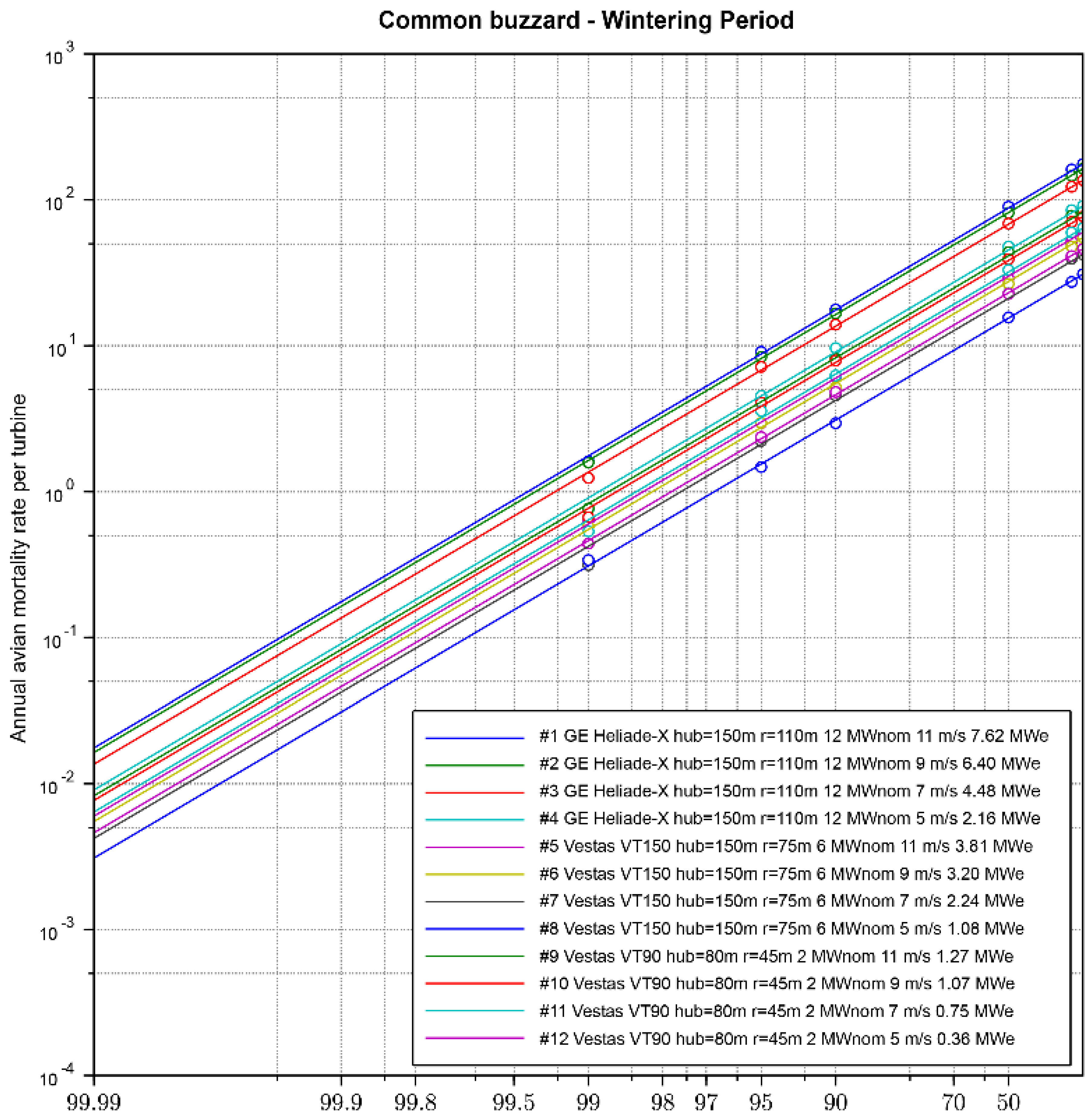
| Model | Number of Turbines | Rotor Diameter (m) | Hub Height (m) |
|---|---|---|---|
| Mitsubishi MWT-1000A | 35 | 61.4 | 69 |
| Vestas V90 | 73 | 90.0 | 105 |
| HSW 250 T | 6 | 28.5 | 50 |
| Bird Flight Type | Number of GPS | Data Collection Period | EMG * Gaussian Mean and Standard Deviation | EMG * Exponential Decay | ||
|---|---|---|---|---|---|---|
| Tracking Positions | From | To | μ (m) | ±σ (m) | τ (m) | |
| Breeding | 13,047 | 6 November 2021 | 29 June 2022 | 68.2 | ±20.4 | 86.2 |
| Migratory | 10,696 | 24 March 2023 | 20 November 2023 | 557.4 | ±372.3 | 184.3 |
| Wintering | 247 | 18 January 2022 | 24 January 2022 | 68.0 | ±30.3 | 33.7 |
| Season | Avoidance (%) | Min Mortality/Turbine | Max Mortality/Turbine |
|---|---|---|---|
| Wintering | 90 | 2 | 12 |
| 95 | 0.3 | 2.5 | |
| 99 | 0.01 | 0.25 | |
| Migratory | 90 | 1 | 6 |
| 95 | 0.1 | 1.2 | |
| 99 | 0.005 | 0.1 | |
| Breeding | 90 | 1.5 | 8 |
| 95 | 0.25 | 2 | |
| 99 | 0.01 | 0.15 |
| Period of Annual Cycle | Number of Collision Victims | Number Per Year in 114 Turbines | Number Per Year Per Turbine |
|---|---|---|---|
| Breeding period | 3 | 0.5 | 0.004386 |
| Migratory period | 2 | 0.3 | 0.002632 |
| Wintering period | 5 | 0.8 | 0.007018 |
| Total 2018–2023 | 10 | 1.6 | 0.014035 |
Disclaimer/Publisher’s Note: The statements, opinions and data contained in all publications are solely those of the individual author(s) and contributor(s) and not of MDPI and/or the editor(s). MDPI and/or the editor(s) disclaim responsibility for any injury to people or property resulting from any ideas, methods, instructions or products referred to in the content. |
© 2025 by the authors. Licensee MDPI, Basel, Switzerland. This article is an open access article distributed under the terms and conditions of the Creative Commons Attribution (CC BY) license (https://creativecommons.org/licenses/by/4.0/).
Share and Cite
Yordanov, N.; Nabielek, H.; Bedev, K.; Zehtindjiev, P. Bird Survival in Wind Farms by Monte-Carlo Simulation Modelling Based on Wide-Ranging Flight Tracking Data of Multiple Birds During Different Seasons. Birds 2025, 6, 50. https://doi.org/10.3390/birds6030050
Yordanov N, Nabielek H, Bedev K, Zehtindjiev P. Bird Survival in Wind Farms by Monte-Carlo Simulation Modelling Based on Wide-Ranging Flight Tracking Data of Multiple Birds During Different Seasons. Birds. 2025; 6(3):50. https://doi.org/10.3390/birds6030050
Chicago/Turabian StyleYordanov, Nikolay, Heinz Nabielek, Kiril Bedev, and Pavel Zehtindjiev. 2025. "Bird Survival in Wind Farms by Monte-Carlo Simulation Modelling Based on Wide-Ranging Flight Tracking Data of Multiple Birds During Different Seasons" Birds 6, no. 3: 50. https://doi.org/10.3390/birds6030050
APA StyleYordanov, N., Nabielek, H., Bedev, K., & Zehtindjiev, P. (2025). Bird Survival in Wind Farms by Monte-Carlo Simulation Modelling Based on Wide-Ranging Flight Tracking Data of Multiple Birds During Different Seasons. Birds, 6(3), 50. https://doi.org/10.3390/birds6030050






